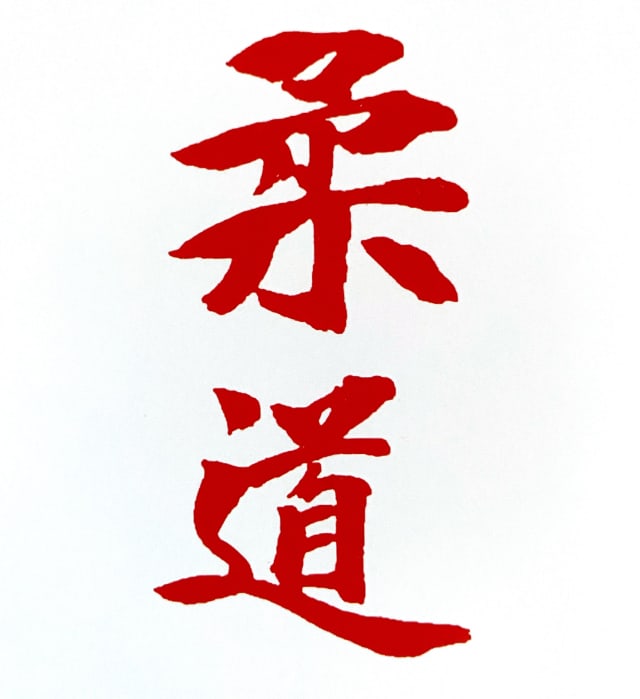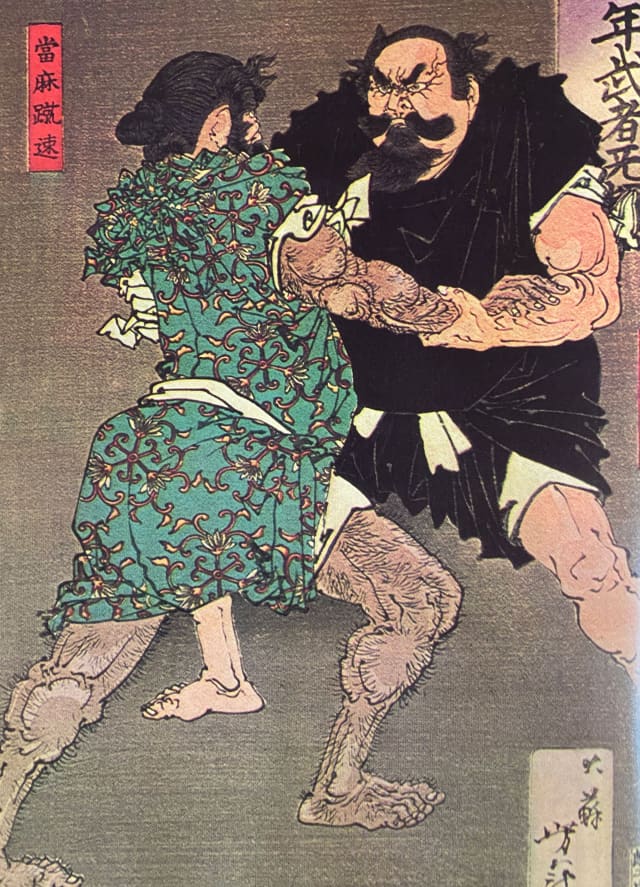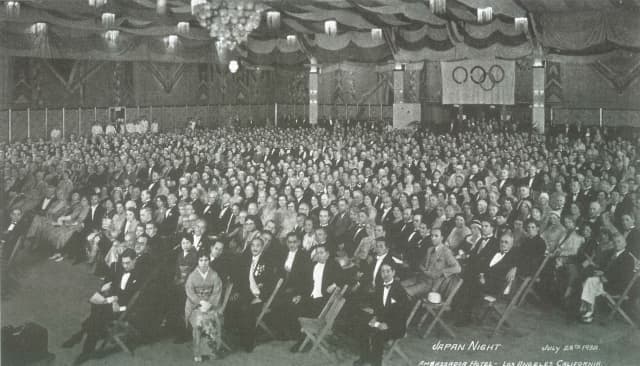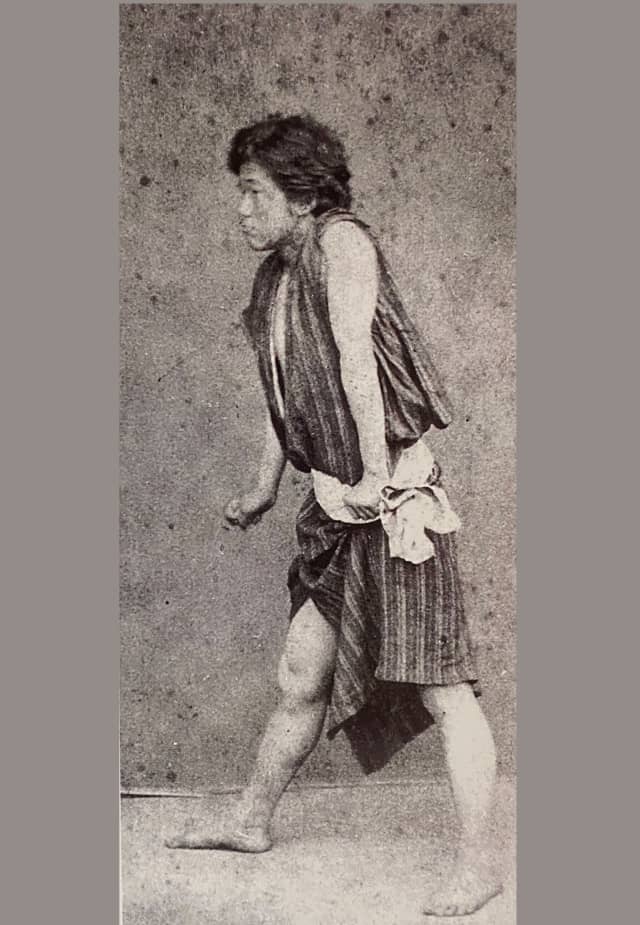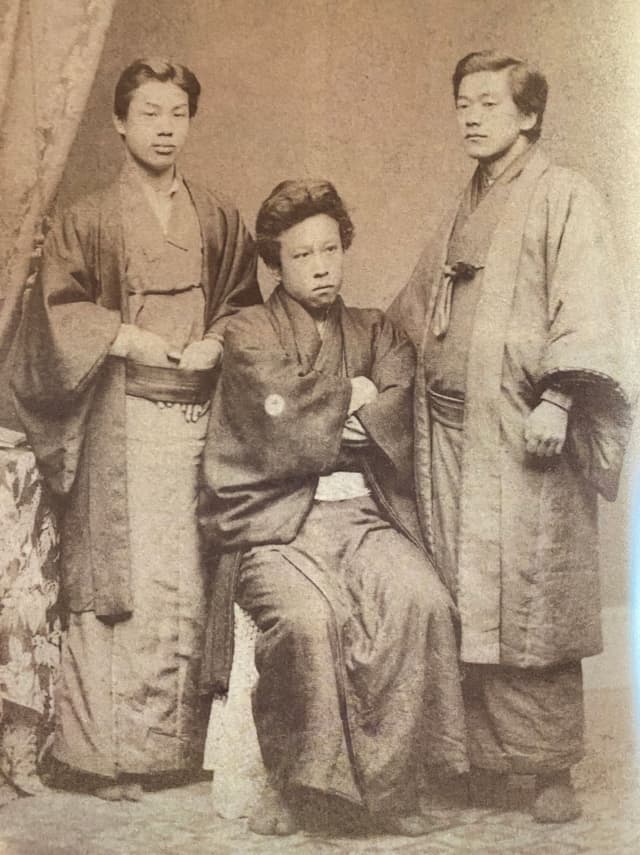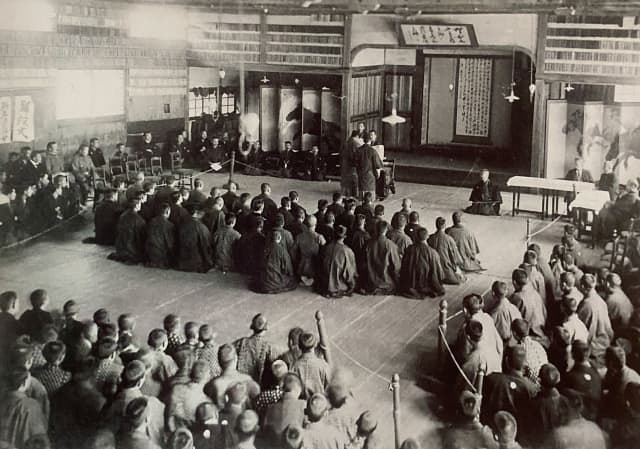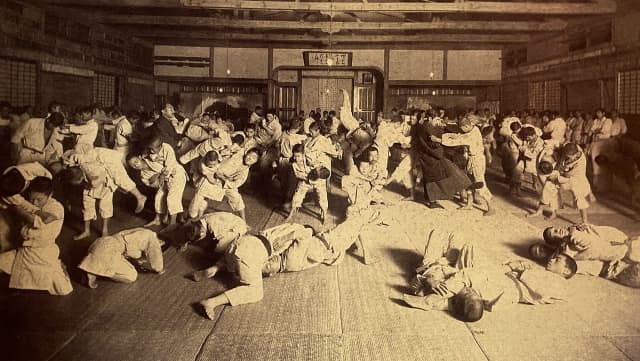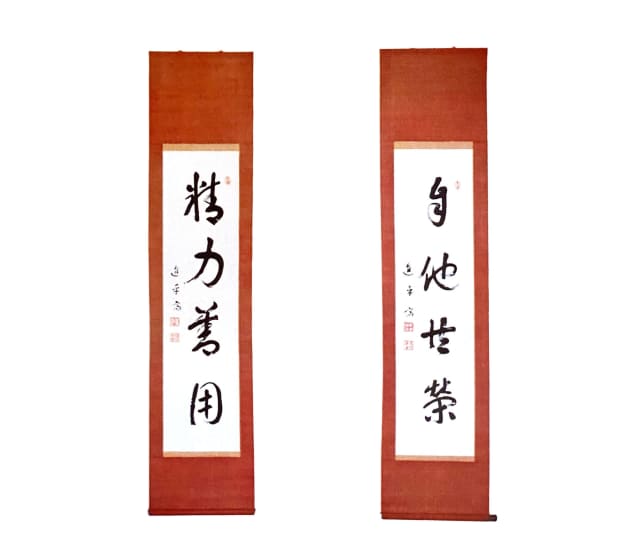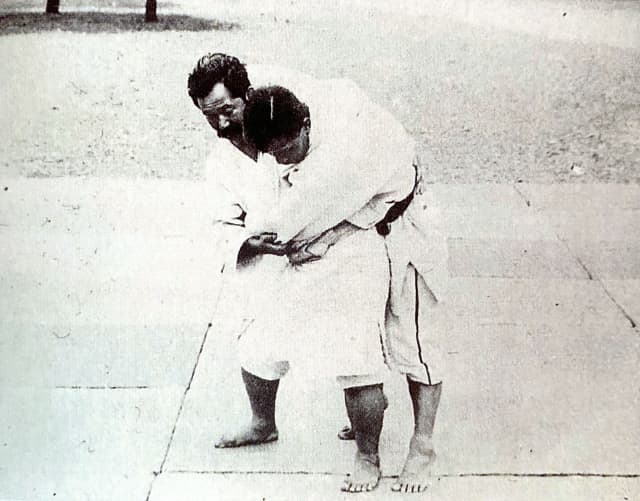In 1938, after the Cairo IOC meeting, Kano Jigoro Shihan again travelled to the U.S. to thank American IOC member Mr. Brundage.
Fast forward to 1964 and it was Mr. Kazushige Hirasawa, who was with Kano Shihan on the Hikawa Maru in 1938, when our sport’s founder passed away on his way back from Cairo, who made the final speech to campaign for the Tokyo Olympics. The IOC President at that time was Mr. Brundage. Reviewing it now, we can see the many ties that existed.
Although this lecture was given 89 years ago, it is meaningful to introduce it at this time, when Japan is trying to overcome various problems and somehow hold the Tokyo 2020 Olympic Games.
THE CONTRIBUTION OF JUDO TO EDUCATION BY PROFESSOR JIGORO KANO “The object of this lecture is to explain to you in a general way what judo is. In our feudal times there were many military exercises, such as fencing, archery, the use of spears, etc. Among them there was one called jujitsu which was a composite exercise, consisting principally of the ways of fighting without weapons but using daggers, swords and other weapons occasionally.
The kinds of attack were chiefly throwing, hitting, choking, holding the opponent down and bending or twisting the opponent’s arms or legs in such a way as to cause pain or fracture. The use of swords and daggers was also taught.
We also had multitudinous ways of defending ourselves against such attacks. Such exercise, in its primitive form, existed even in our mythological age but systematic instruction, as an art, dates only from about three hundred and fifty years ago.
In my young days I studied this art with three eminent masters of the time. The great benefit derived from the study of it led me to make up my mind to go on with the subject more seriously and in 1882 I started a school of my own and called it Kodokan. Kodokan literally means ‘a school for studying the way;’ the meaning of ‘the way’ being the concept of life itself.
I named the subject and I teach judo instead of jujitsu. In the first place I will explain to you the meaning of these words.
JU means ‘gentle’ or ‘to give way,’ jitsu, an ‘art’ or ‘practice’ and DO, ‘way’ or ‘principle’ so that jujitsu means an art or practice of gentleness or of first giving way in order ultimately to gain the victory; while judo means the way or principle of the same.
Let me now explain what this gentleness or giving way really means. Suppose we assume that we may estimate the strength of man in units of one. Let us say that the strength of a man standing in front of me is represented by ten units, whereas my strength, less than his, is represented by seven units. Then if he pushes me with all his force I shall certainly be pushed back or thrown down, even if I use all my strength against him. This would happen because I used all my strength against him, opposing strength with strength.
If, instead of opposing him, I were to give way to his strength by withdrawing my body just as much as he had pushed, remembering at the same time to keep my balance, then he would naturally lean forward and thus lose his balance. In this new position, he may have become so weak (not in actual physical strength but because of his awkward position) as to have his strength represented for the moment by, say, only three units, instead of his normal ten units. Meanwhile, I, by keeping my balance, retain my full strength, as originally represented by seven units. Here, then, I am momentarily in an advantageous position, and I can defeat my opponent using only half of my strength, that is half of my seven units, or three and a half, against his three. This leaves half of my strength available for any purpose.
In case I had greater strength than my opponent I could of course push him back but even in this case, that is, if I had wished to push him back and had the power to do so, it would be better first for me to have given way, because by so doing I should have greatly economised my energy.
That is one simple instance of how an opponent may be beaten by giving way. Other instances may be given.
Suppose that my opponent tries to twist my body, intending to cause me to fall down. If I were to resist him I should surely be thrown down, because my strength to resist him is not sufficient to overcome his but if, on the other hand, I give way to him and while doing so I pull my opponent, throwing my body on the ground voluntarily, I can throw him very easily. I will give another example.
Suppose that we are walking along a mountain road with a precipice on the side and that this man had suddenly sprung upon me and tried to push me down the precipice. In this case I could not help being pushed over the precipice if I attempted to resist him, while, on the contrary, if I give way to him and at the same time turn my body round and pull my opponent towards the precipice, I can easily throw my opponent over the edge and at the same time throw my own body safely to the ground.
I can multiply these examples to any extent but I think those which I have given will suffice to enable you to understand how I may beat an opponent by giving way and as there are so many instances in jujitsu contest where this principle is applied, the name jujitsu (that is, the gentle or giving way art) came to be the name of the whole art but strictly speaking, real jujitsu is something more.
The way of gaining victory over an opponent with jujitsu is not confined to gaining victory only by giving way. We sometimes hit, kick and choke in physical contest but in contradistinction to giving way, these are forms of direct attack.
Sometimes an opponent takes hold of one’s wrist. How can one possibly release oneself without using one’s strength against an opponent’s grip? The same thing can be asked when somebody grips one from behind. If, thus, the principle of giving way cannot cover all the methods used in jujitsu contest, is there any principle which really covers the whole field?
Yes, there is and that is the principle of the maximum efficient use of mind and body and jujitsu is nothing but an application of this all-pervading principle in attack and defence.
Can this principle be applied to other fields of human activity? Yes, this same principle can be applied to the improvement of the human body, making it strong, healthy and useful and so constitutes physical education. It can also be applied to the improvement of intellectual and moral power and in this way constitutes mental and moral education.
It can at the same time be applied to the improvement of diet, clothing, housing, social intercourse and methods of business, thus constituting the study and training of living. I gave this all-pervading principle the name of ‘judo.’
So judo, in its fuller sense, is a study and a method of training in mind and body as well as in the regulation of life and affairs. Judo, therefore, in one of its phases, can be studied and practised with attack and defence as its core activity.
Before I started Kodokan, this attack and defence phase of judo was only studied and practised in Japan, under the name of jujitsu, sometimes called taijutsu, meaning the art of managing the body or yawara, the ‘gentle management,’ but I came to think that the study of this all-pervading principle is more important than the mere practice of jujitsu because the real understanding of the principle not only enables one to apply it to all phases of life but is also of great service in the study of the art of jujitsu itself.
It is not only through the process I followed that one can come to grasp this principle. One can arrive at the same conclusion by philosophical interpretation of the daily transaction of business or through abstract philosophical reasoning.
When I started to teach judo I thought it advisable to follow the same course as I took in the study of the subject, because by so doing I could make the body of my pupil healthy, strong and useful. At the same time, I could assist him to grasp this all-important principle gradually. For this reason I began the instruction of judo with training in randori and kata.
Randori, meaning ‘free practice,’ is practised under conditions of actual contest. It includes throwing, choking, holding the opponent down and bending or twisting his arms or legs. The two combatants may use whatever methods they like, provided they do not hurt each other and obey the rules of judo concerning etiquette, which are essential to its proper working.
Kata, which literally means ‘form,’ is a formal system of prearranged exercises, including hitting, cutting, kicking, thrusting, etc, according to rules under which each combatant agrees beforehand exactly what their opponent is going to do. The training in hitting, kicking, cutting and thrusting are taught in kata and not in randori, because if they were used in randori cases of injury might frequently occur, while when taught in kata no such injury is likely to happen because all the attacks and defences are prearranged.
Randori may be practised in various ways. If the object is simply training in the method of attack and defence, the attention should be especially directed to training in the most efficient ways of throwing, bending or twisting, without special reference to developing the body or to mental and moral culture. Randori can also be studied with physical education as its main objective. From what I have already said, for anything to be ideal it must be performed on the principle of maximum efficiency.
We will see how the existing systems of physical education can stand this test. Taking athletics as a whole, I cannot help thinking that they are not the ideal form of physical education, because every movement is not chosen for all-round development of the body but for attaining some other definite objective.
Furthermore, as we generally require special equipment and sometimes quite a number of persons to participate in them, athletics is fitting as training for select groups of persons and not as the means of improving the physical condition of a whole nation.
This holds true with boxing, wrestling and different kinds of military exercises that are practised all over the world. Then people may ask, “Are not gymnastics an ideal form of national physical training?”
To this I answer that they are an ideal form of physical education from their being contrived for all-round development of the body and not necessarily requiring special equipment and participants but gymnastics lacks very important things, essential to the physical education of a whole nation. The defects are:
1. Different gymnastic movements have no meaning and naturally are devoid of interest.
2. No secondary benefit is derived from their training.
3. Attainment of ‘skill’ (using the word ‘skill’ in a special sense) cannot be sought or acquired in gymnastics as in some other exercises.
From this brief survey of the whole field of physical education, I can say that no ideal form has yet been invented to fill the necessary conditions for such physical education. This ideal form can only be devised from a study based on maximum-efficiency. In order to fulfil all those conditions or requirements, a system of all round development of the body as a primary consideration must be devised, as in the case of gymnastics.
Next, the movements should have some meaning so that they may be engaged in with interest. Again, the activities should be such as to require no large space, special dress or equipment. Furthermore, they must be such as could be done individually as well as in groups.
Those are the conditions or requirements for a satisfactory system of physical education for a whole nation. Any system that can meet those requirements successfully may, for the first time, be regarded as a programme of physical education based on the principle of maximum efficiency. I have been studying this subject for a long time and have succeeded in devising two forms which may be said to fulfil all those requirements.
One form is what I named ‘representative form.’ This is a way of representing ideas, emotions and different motions of natural object by the movements of limbs, body and neck. Dancing is one instance of such, but originally dancing was not devised with physical education for its objective and can therefore not be said to fulfil those requirements.
It is possible to devise special kinds of dancing made to suit persons of different sex and mental and physical condition and made to express moral ideas and feelings, so that conjointly with the cultivation of the spiritual side of a nation it can also develop the body in a way suited to all. This ‘representative form’ is, I believe, in one way or other practised in America and Europe and you can, I think, imagine what I mean. Therefore I shall not deal with it any further here.
There is one other form which I named ‘attack and defence form.’ In this I have combined different methods of attack and defence in such a way that the result will align with the harmonious development of the whole body. Ordinary methods of attack and defence taught in jujitsu cannot be said to be ideal for the development of the body, therefore I have combined them especially so that they fulfil the conditions necessary for the harmonious development of the body.
This can be said to meet two purposes:
(1) bodily development and (2) training in the art of contest. As every nation is required to provide for national defence, so every individual must know how to defend oneself.
In this age of enlightenment, nobody would care to prepare either for national aggressions or for individual violence to others but defence in the cause of justice and humanity must never be neglected by a nation or by an individual. I shall show you this method of physical education, in attack and defence form, by actual practice. This is divided into two kinds of exercises: one is individual exercise and the other is exercise with an opponent.
From what I have explained and shown via practice, you have no doubt understood what I mean by physical education based on the principle of maximum efficiency.
Although I strongly advocate that the physical education of a whole nation should be conducted on that principle, at the same time I do not mean to lay little emphasis on athletics or various kinds of martial exercise. Although they cannot be deemed appropriate as physical education for a whole nation, as a culture of a group or groups of persons, they have their special value and I by no means wish to discourage them, especially randori in judo.
One great value of randori lies in the abundance of movements it affords for physical development. Another value is that every movement has some purpose and is executed with spirit, while in ordinary gymnastic exercises movements lack interest. The objective of systematic physical training in judo is not only to develop the body but to enable a man or a woman to have perfect control over mind and body and to make him or her ready to meet any emergency, whether that be a pure accident or an attack by others.
Although exercise in judo is generally conducted between two persons, both in kata and in randori and in a room specially prepared for the purpose but that is not always necessary. It can be practised by a group or by a single person, on the playground or in an ordinary room. People imagine that falling in randori is attended with pain and sometimes with danger but a brief explanation of the way one is taught to fall will enable them to understand that there is no such pain or danger.
I shall now proceed to speak of the intellectual phase of judo. Mental training in judo can be done by kata as well as by randori but more successfully by the latter. As Randori is a competition between two persons, using all the resources at their command and obeying the prescribed rules of judo, both parties must always be wide awake and be endeavoring to find weak points of the opponent, being ready to attack whenever opportunity allows.
Such an attitude of mind in devising means of attack tends to make the pupil earnest, sincere, thoughtful, cautious and deliberate in all his dealings. At the same time one is trained for quick decision-making and prompt action, because in randori unless one decides quickly and acts promptly one will always lose their opportunity either in attacking or in defending. Again, in randori each contestant cannot tell what their opponent is going to do, so each must always be prepared to meet any sudden attack by the other. Accustomed to this kind of mental attitude, one develops a high degree of mental composure, of poise. Exercise of the power of attention and observation in the gymnasium or place of training, naturally develops such power, which is so useful in daily life.
For devising a means of defeating an opponent, the exercise of the power of imagination, of reasoning and of judgement, is indispensable and such power is developed naturally in randori. Again, as the study of randori is the study of the relationship, mental and physical, existing between two competing parties, hundreds of valuable lessons may be derived from this study, but I will content myself for the present by giving just a few more examples.
In randori we teach the pupil always to act on the fundamental principle of judo, no matter how physically inferior his opponent may seem to him and even if he can by sheer strength easily overcome the other. If he acts against this principle the opponent will never be convinced of his defeat, whatever brutal strength may have been used on him.
It is hardly necessary to call your attention to the fact that the way to convince your opponent in an argument is not to push this or that advantage over him be it from power, from knowledge or from wealth, but to persuade him in accordance with the inviolable rules of logic.
This lesson that suasion, not coercion, is efficacious, which is so valuable in actual life, we may learn from randori. Again we teach the learner, when he has recourse to any trick in overcoming his opponent, to employ only as much of his force as is absolutely required for the purpose in question, cautioning him against either an over or an under-exertion of force.
There are not a few cases in which people fail in what they undertake simply because they go too far, not knowing where to stop and vice versa. To take still another instance, in randori, we teach the learner, when they face an opponent who is madly excited, to score a victory over them, not by resisting directly with might and main, but by playing them until the very fury and power of the latter expends itself. The usefulness of this attitude in everyday transactions with others is patent.
As is well known, no amount of reasoning could avail us when we are confronted by a person who is so agitated as to seem to have lost their temper. All that we have to do in such a case is to wait until their passion wears itself out. All these teachings we learn from the practice of randori.
Their application to the conduct of daily affairs is a very interesting subject of study and is valuable as intellectual training for young minds. I will finish my talk about the intellectual phase of judo by referring shortly to the rational means of increasing knowledge and intellectual power.
If we closely observe society, we notice everywhere the way in which we foolishly expend our energy in the acquisition of knowledge. All our surroundings are always giving us opportunities for gaining useful knowledge but are we not constantly neglecting the best use of such opportunities? Are we always making the best choice of books, magazines and newspapers we read? Do we not often find out that the energy which might have been spent for acquiring useful knowledge is often used for amassing knowledge which is prejudicial, not only to self but also to society?
Besides the acquisition of useful knowledge, we must endeavour to improve our intellectual powers, such as memory, attention, observation, judgement, reasoning, imagination, etc. This we should not do in a haphazard manner but in accordance with psychological laws, so that the relationship between those powers, one with the other, shall be well harmonised.
It is only by following the principle of maximum efficiency faithfully, that is judo, that we can achieve the objective of increasing our knowledge and intellectual power rationally. I shall now speak about the moral phase of judo.
It is not my intention to speak of the moral discipline given to students in the exercise room, such as the observance of the regular rules of etiquette, courage and perseverance, kindness and respect for others, impartiality and fair play, so much emphasised in athletic sports throughout the world. The training in judo has a special moral import in Japan because judo, together with other martial exercises, was practised by our samurai, who had a high code of honour, the spirit of which has been bequeathed to us through the teaching of the art.
In this connection I wish to explain to you haw the principle of maximum efficiency helps us in promoting moral conduct.
A man is sometimes very excitable and prone to anger for trivial reasons but when one comes to consider that to be excited is an unnecessary expenditure of energy, giving benefit to nobody but often doing harm to self and others, it will be seen that students of judo must refrain from such conduct.
A man is sometimes despondent from disappointment, is gloomy and has no courage to work. To such a man judo comes with the advice to find out what is the best thing he can do under the existing circumstances.
Paradoxical as it may seem, such a man is, to my mind, in the same position as one who is at the zenith of success. In either case, there is only one course to follow, that is, what after due consideration he deems to be the best course of action at the time.
Thus the teaching of judo may be said to lead a man from the depths of disappointment and lethargy to a state of vigorous activity with a bright hope for the future.
The same reasoning applies to those persons who are discontented. Discontented persons are often in a sulky state of mind and blame other people for what is their own fault and do so without attending to their own business. The teaching of judo will make such persons understand that such conduct is against the principle of maximum efficiency and will make them realise that by the faithful pursuance of that principle they will become more cheerful.
Thus the teaching of judo is, in a variety of ways, serviceable to the promotion of moral conduct.
Finally, I wish to add a few words to the emotional phase of judo. We are all aware of the pleasurable sensation given to the nerves and muscles through exercise and we also feel pleasure at the attainment of skill, in the use of our muscles and also through the sense of superiority over others in contest.
Besides these pleasures there is that love of beauty and delight in it derivable from assuming graceful attitudes and performing graceful movements and also in seeing such in others. The training in these, together with the pleasure obtainable from watching various movements symbolical of different ideas, constitutes what we call the emotional or the aesthetic phase of judo.
I believe you have already come to see what kind of thing judo really is, in contradistinction to the jujitsu of feudal times.
If I now state in a concise form what I have said, it might be summed up as follows: Judo is a study and a training in mind and body as well as in the regulation of one’s life and affairs.
From the thorough study of the different methods of attack and defence I became convinced that they all depend on the application of one all-pervading principle, namely: whatever be the objective, it can best be attained by the highest or maximum efficient use of mind and body for that purpose.
Just as this principle applied to the methods of attack and defence constitutes jujitsu, so does this same principle, applied to physical, mental and moral culture, as well as to ways of living and carrying on business, constitute the study of and the training in, those things. Once the real import of this principle is understood, it may be applied to all phases of life and activity and enable one to lead the highest and the most rational life.
The real understanding of this principle need not necessarily be arrived at through training in the methods of attack and defence but as I came to conceive of this idea through training in these methods, I made such training in contest and the training for the development of the body the regular means of arriving at the principle.
This principle of maximum efficiency, when applied to the keying-up or perfecting of social life, just as when applied to the coordination of mind and body, in the science of attack and defence, demands, first of all, order and harmony among its members and this can only be attained through mutual aid and concession, leading to mutual welfare and benefit.
The final aim of judo, therefore, is to inculcate in the minds of people a spirit of respect for the principle of maximum efficiency and of mutual welfare and benefit, leading them so to practise them that people individually and collectively can attain to the highest state and at the same time develop the body and learn the art of attack and defence.
If we observe the actual state of society all over the world closely, notwithstanding the fact that morality in all its forms (religions, philosophical and traditional) is meant to improve people’s conduct in society and make the world ideal, the fact seems quite the contrary. We notice vices, quarrels and discontent in every level of society, from the highest to the lowest.
While we are taught hygiene and correct ways of living in school, from childhood up to mature age, we are still prone to neglect the rules of good, clean living and of hygienic and orderly lives. The actual facts prove that our society is lacking in something which, if brought to light and universally acknowledged, can remodel the present society and bring greater happiness and satisfaction to this world.
This is the teaching of maximum efficiency and mutual welfare and benefit.
I do not mean to say that our time-honoured moral precepts and hygienics should be shelved. On the contrary, let those precepts and that advice be respected ever as they used to be but in addition to these, our principle of maximum efficiency and mutual welfare and benefit should ever be paramount.
This I say emphatically, because in this age of criticism and new ideals, for any teaching to have effect, it must have behind it some indubitable reason or fact. We do not hear the thinking man today say, “Because I believe in such and such a thing, therefore you must believe in it,” or, “I came to such and such a conclusion through my own reasoning; therefore you must also come to the same conclusion.”
Whatever one affirms must be based on facts or reasoning which no sane person can deny or doubt.
Certainly none can deny the value of the principle ‘Whatever be the objective, it can best be attained by the highest or maximum efficient use of mind and body for that purpose.’ Again, none can deny that it is only by aiming at mutual welfare and benefit that every member of society can keep from discord and quarrelling and live in peace and prosperity.
Is it not because of the universal recognition of these facts that people have come to talk so much about efficiency and scientific management and that everywhere these are being advocated?
In addition to this, the principle of give and take is more and more coming to be the determining factor in the lives of all human beings. Is it not because this principle of mutual welfare and benefit has been recognised that we came to form the League of Nations and the great powers of the world came to meet for the decrease of naval and military armaments?
These movements are also automatic acknowledgments of the crying need for efficiency and mutual welfare and benefit.
They must be fostered by the educational forces of every country in which judo should have a prominent part."
As the Games are about to start, it is important to remember that judo is not only a sport, it is way more than that and Kano Jigoro’s teachings are here to remind us that we have a duty to transmit the judo philosophy.

